Sexual violence during the armed conflict
The civilian population, which is often targeted in the context of ongoing armed conflicts, is frequently affected by various methods and strategies of warfare, including prohibited ones. Sexual violence has been used as a tool of terror against both civilians and combatants for centuries and has devastating and long-lasting consequences for society as a whole. Unfortunately, regardless of the strict prohibition under human rights, international criminal and humanitarian law,[1] sexual violence during war is still a frequently used tool, threatening human dignity, life and health. Sexual violence can take various forms and manifestations and also differs in its severity on a case-by-case basis. The World Health Organization (WHO) defines sexual violence as:
Any sexual act, attempt to obtain a sexual act, unwanted sexual comments or advances, or acts to traffic or otherwise directed against a person’s sexuality using coercion, by any person regardless of their relationship to the victim, in any setting, including but not limited to home and work.[2]
Being a topic too taboo to discuss due to a number of cultural, religious and ethnic norms, such crimes often result in the impunity of the perpetrator, causing irreparable physical and psychological trauma to victims.
The number of sexual crimes that are registered in the Database of the Natalia Estemirova Documentation Center (hereinafter the Database), committed in the context of the conflict in the North Caucasus, is limited and disproportionate when compared to other crimes committed during the war.[3] Among the registered cases, the Database lists crimes of a sexual character to include insults and humiliation, acts of a sexual nature by threat of force or coercion, rape (including gang rape or with the use of foreign objects), castration and other crimes.
The Database contains information on at least 45 victims of sexual violence who suffered during the conflict in the entire region. 41 incidents took place in the Chechen Republic and more than half of those cases, that is 26 incidents, occurred in 2000. There are no cases of sexual violence occurring after 2005 recorded in the Database (see chart 1).[4]
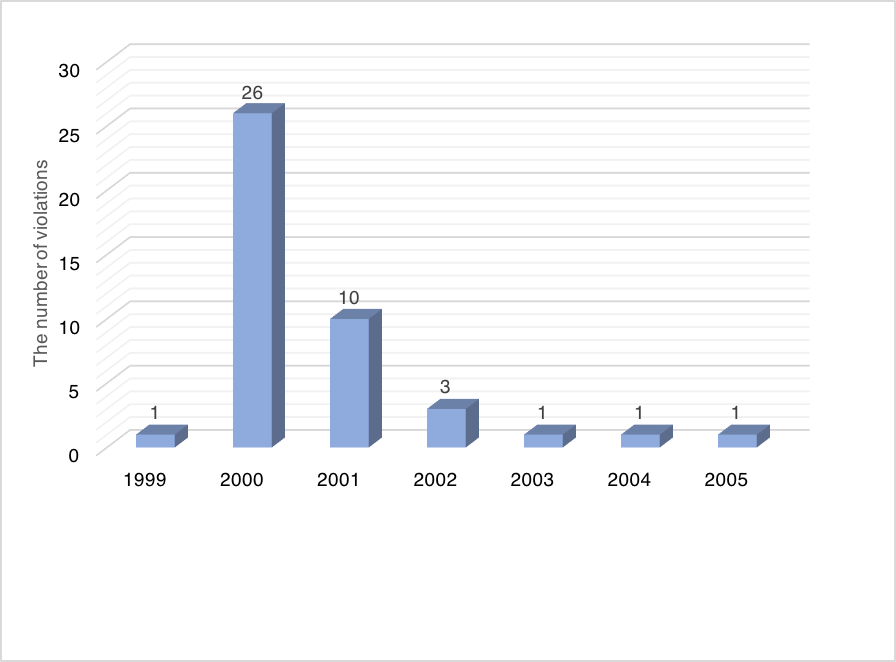
30 persons, or 73% of the total number of victims of sexual violence in the Chechen Republic, were civilians (see chart 2).[5] The majority of them, 28 victims, suffered at the hands of the Russian security forces or forces acting in their interests. In two cases, the perpetrators could not be identified.
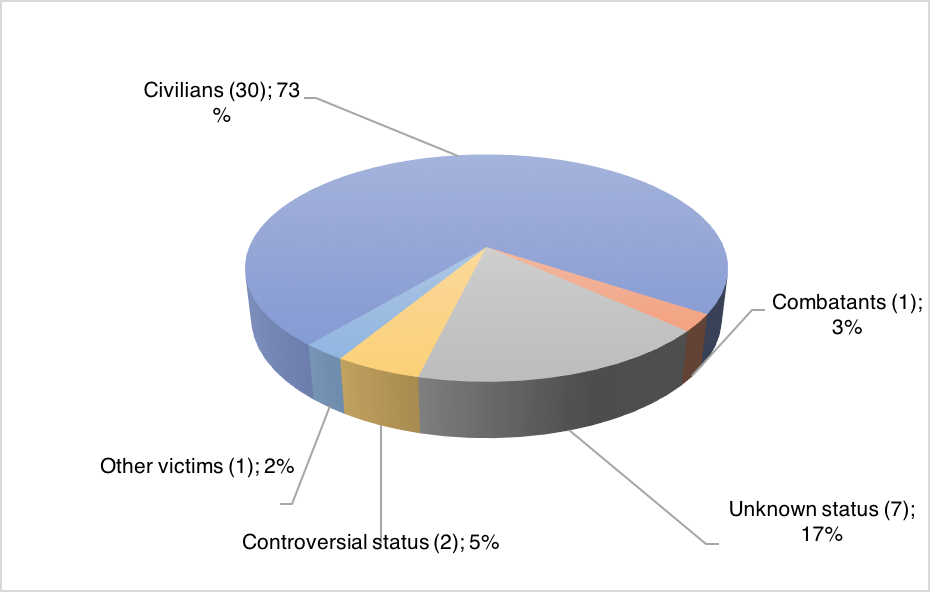
In at least 31 of all reported cases in the Chechen Republic, victims were women and often those belonging to a vulnerable group. For instance, two of the victims were minors and at least three women were pregnant at the time of the attack; two of them were killed, and one was released in exchange for a ransom. The following is an eyewitness account of the sexual violence perpetrated in the Republic, the eyewitness himself having been harassed, tortured and kept in a water tank by military personnel:
But the worst of all, the most painful and humiliating, was when those animals forced us to look at girls, who were forced to stand with their hands stretched out, while they were being raped. Moreover, they did it in the most perverted manner. Later R. confessed that sometimes she was forced to “serve” 20-30 people, and T. was pregnant. X was subjected to violence as well.[6]
Among the victims of sexual violence, there were at least ten men, three of whom were civilians. Some of the reported cases are particularly horrifying due to the extent of their cruelty. One such case resulted in a public outcry. On 6 September 2000, on the outskirts of the Naurskaya village, a 55-year-old local shepherd was subjected to sexual violence. Four military personnel from the federal forces castrated the victim using a fishing line and forced the man to swallow the hacked parts of his sexual organ. The abuse did not end there. The military personnel subsequently raped the man using a stick. Two days after the incident, local residents turned to the commandant of the village demanding that the perpetrators be punished. However, following talks with the commandant, the victim abruptly changed his testimony. Shockingly, as per the victim’s initial testimony, the military personnel had told him that he was the fourth victim to be subjected to such cruel treatment.[7]
Other victims belonging to vulnerable groups were those with sicknesses, disabilities, and those whose freedom was restricted at the time of the violation. In one case, the victim, who was severely disabled, was kidnapped in Shali on 5 March 2004 by unknown military personnel and subjected to intolerable torture. He was beaten for a long period of time, subjected to electric shocks and sexually abused. According to the victim:
The people who tortured me found more elaborated methods of torture. They tied my penis and scrotum with a rope and subsequently pulled the rope and tied its other end to a hard object. Then they began to pull the end of the rope. At that moment, I was in hellish pain. Once they relaxed the rope, the same questions were asked again.[8]
In search for justice, the man turned to human rights organizations and the district prosecutor’s office.
Often, sexual violence was accompanied by other human rights violations. The Database counts at least 11 such victims whose right to life was also infringed, meaning that the victim either disappeared or was killed following the sexual violence. Eight of these victims were killed with extreme cruelty. One of the victims was a young man who, on 1 April 2001 in the village of Alkhan-Yurt, was kidnapped by the military from his own house at night in front of his relatives. The provocative nature of this crime and the alleged impunity of the perpetrators was such that on the same day the military brought the bare corpse of the victim back to his house and threw it outside. There were signs of strangulation on his neck, his jaw was broken and his back was severely scraped due to being dragged along the ground. The individuals who washed the body of the victim claimed that it also bore signs of rape.[9]
In at least 11 cases, in addition to the perpetration of sexual violence, the right to respect for the private and family life of civilians was also violated. It was not uncommon for military personnel to rape women and girls in front of their families. For example, on 29 December 2001 in the village of Gekhi of the Urus-Martanovsky District, Russian military personnel burst into the house of a civilian and raped the owner in front of her son. Following this, the mother and son were tied together and blown up.[10] In another case, during a sweeping operation (zachistka) in the city of Argun in December 2001, military personnel attempted to kidnap a young woman – a mother of two small children – in front of her family. According to the young woman’s mother:
In the presence of all [the military] began to harass her. They stripped her to the waist, even her bra was taken off. They grabbed her breasts, while saying dirty words and insulting her. They wanted to take her with them.[11]
The relatives who prevented the kidnapping acknowledged that they could no longer live in their village.
As can be seen from chart 3,[12] cases of sexual violence were recorded in ten districts of the Chechen Republic, with the majority occurring in Grozny and the Naursky region (13 cases in each of the locations).
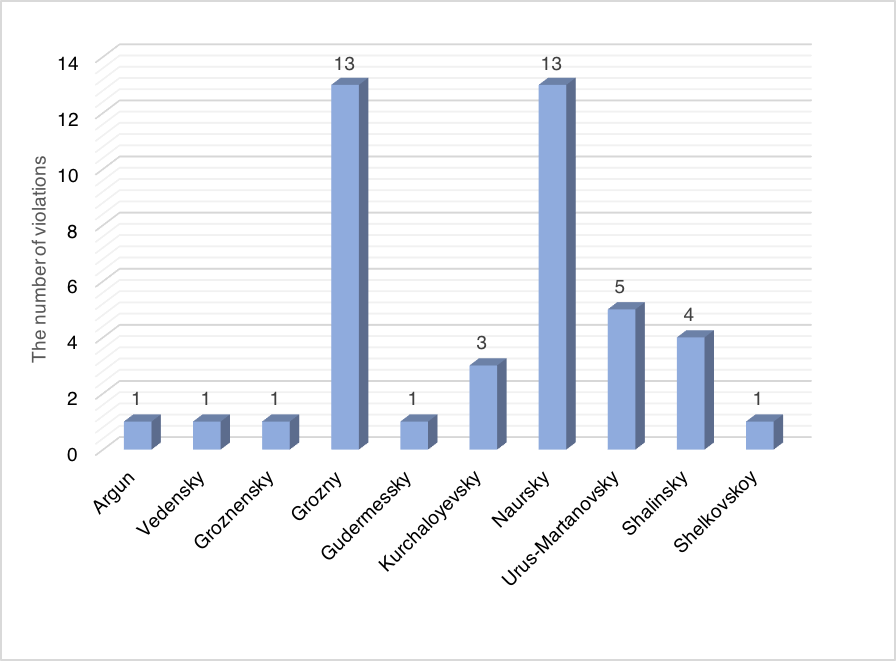
Moreover, despite the number of registered cases of sexual violence in the Database, the actual number of victims may vary significantly. Victims of sexual violence rarely seek justice, preferring to deal with the consequences of the crimes themselves, though not always successfully. According to information from the Natalia Estemirova Documentation Center, at least one victim is presumed to have committed suicide as a result of the sexual violence.[13] The Database reveals that these often “invisible”[14] yet destructive crimes of sexual violence have caused irrevocable injuries to the victims, their relatives and the entire community in the context of the military conflict in the Chechen Republic.
The statistics were updated on 20 March 2019.
The data is subject to change in view of the ongoing work by the Natalia Estemirova Documentation Center on the search and identification of victims of the armed conflict.
Audio library
Listen to the story of a victim of rape and robbery carried out by soldiers.
For details on this story, see the “Audio” section.
Media library
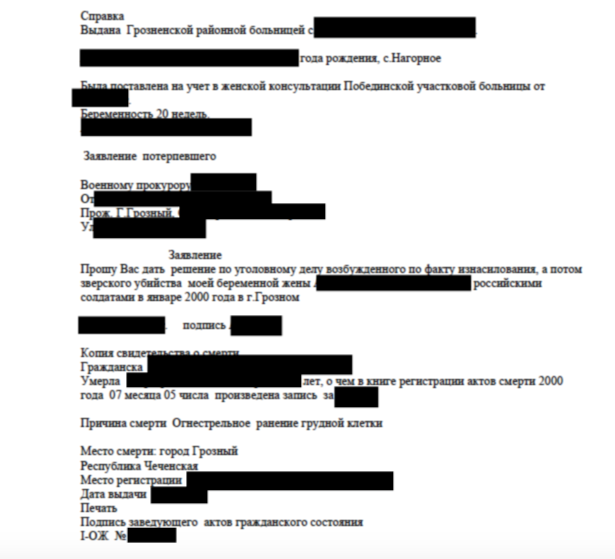
NEDC document 11334 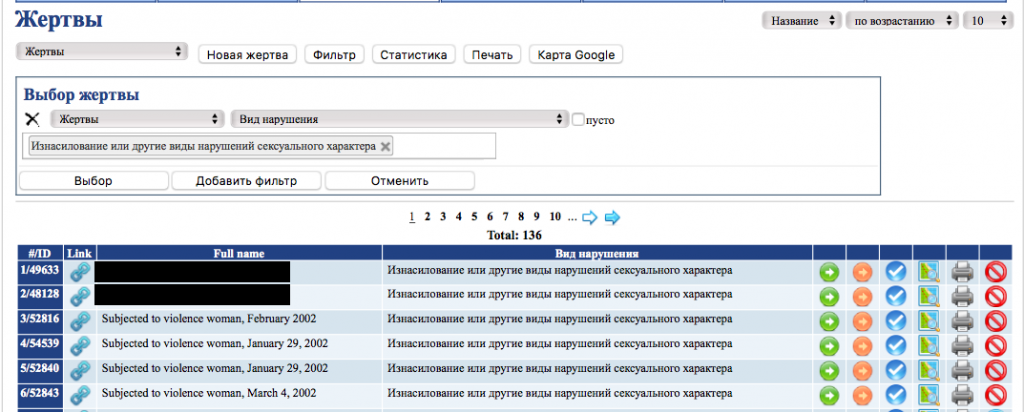
NEDC database 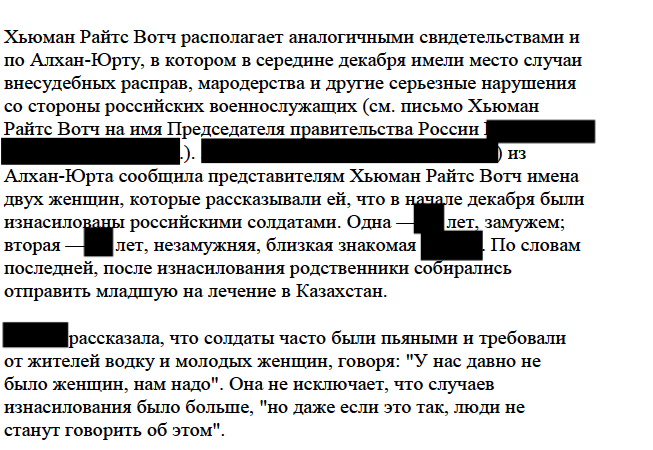
NEDC document 27559 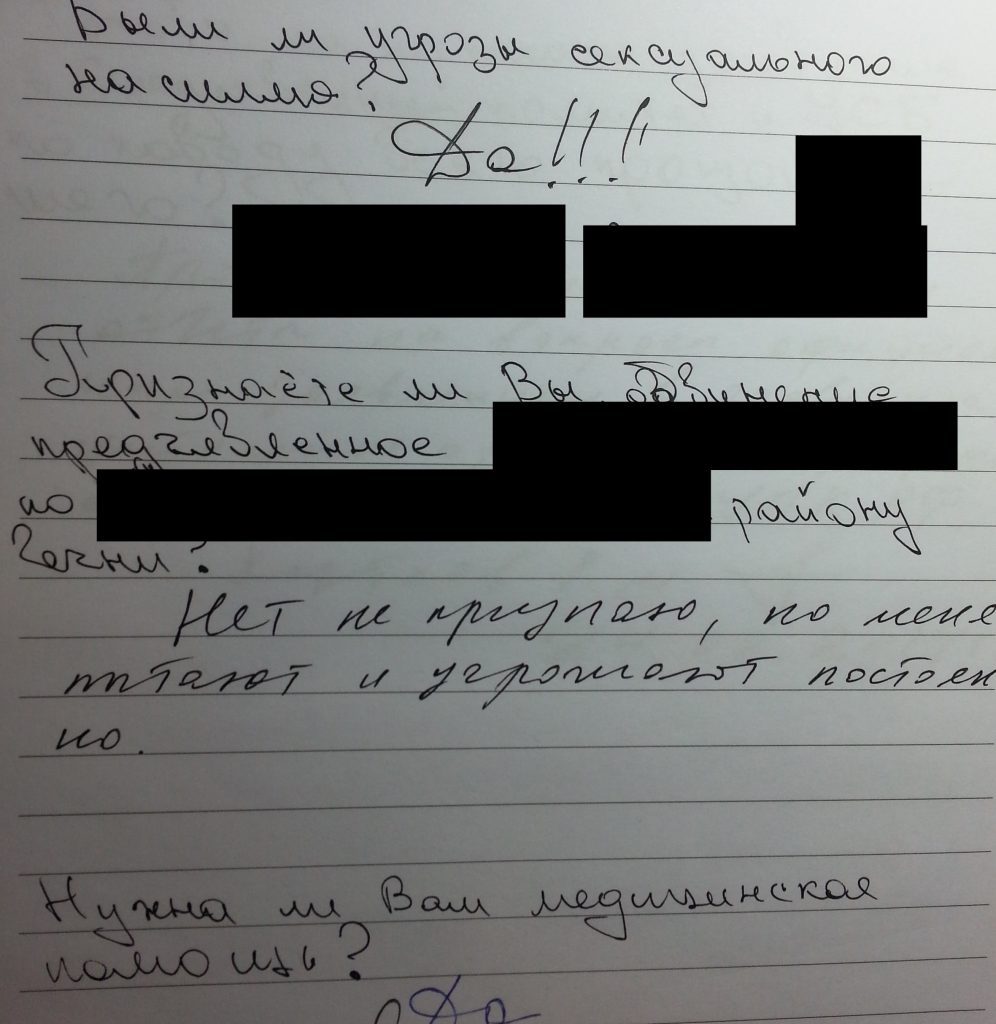
NEDC document 33388 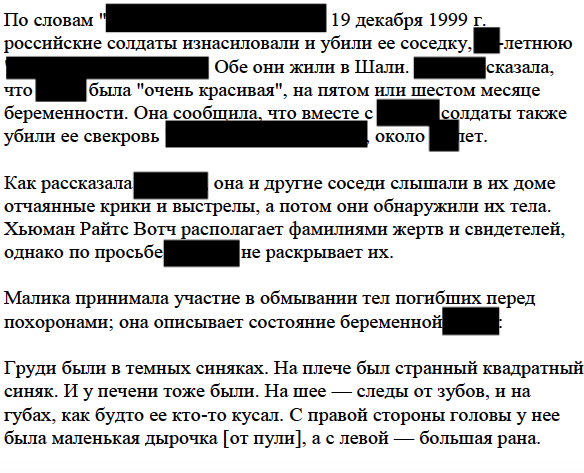
NEDC document 27559 
NEDC document 27549
References
[1]International Journal of the Red Cross, «Sexual Violence in a Situation of Armed Conflict: Violation of International Humanitarian Law and Human Rights Law», https://www.icrc.org/ru/download/file/27907/894_irrc_gaggioli_rus_web.pdf.
[2]World Health Organization (WHO), Violence and its impact on health. Report on the situation in the world (ed. Etienne G. Krug and others). Moscow publishing house. The whole world, 2013, p. 155.
[3]See other publications on the NEDC website.
[4]There is uncertainty of the exact date of the commission of these crimes due to the lack of information.
[5]The Natalia Estemirova Documentation Center Project uses the definitions of civilian population and combatants/irregular fighters depending on the degree of involvement of the population in hostilities, based in the context of the non-international armed conflict in Chechnya,
[6]Document № 7966.
[7]Incident № 3076 «Sexual abuse of a man in the Naurskaya village, September 2000».
[8]Document № 6269.
[9]Incident № 892 «Killing of A.M. B. in Alkhan-Yurt, April 1, 2001».
[10]Incident № 3334 «Killing of the family I-ov in Gekhi, December 2001».
[11]Document № 10589.
[12]For the districts missing in the schedule (Achkhoi-Martanovsky, Galanchzhosky, Itum-Kalinsky, Nadterechny, Nozhay-Yurtovsky, Sunzhensky, Sharoysky and Shatoysky districts) no record of sexual crimes exists in the N. Estemirova Documentation Center Database. In addition, two incidents were recorded under “Famous landmarks” in the Database. In these cases information is available about a specific landmark relating to the incident, but not the area (for example, the incident occurred at a specific checkpoint). Furthermore, in four cases the sexual violence against the victim occurred in several locations which has created some uncertainty in relation to the geography of the cases.
[13]Victim № 58556.
[14]International Journal of the Red Cross, Sexual Violence in a Situation of Armed Conflict: Violation of International Humanitarian Law and Human Rights Law (G. Gaggioli), Number 894, Volume 96, p. 2, https://www.icrc.org/ru/download/file/27907/894_irrc_gaggioli_rus_web.pdf.
